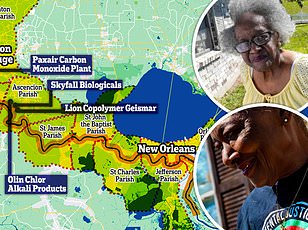Scientists make deadly discovery in New York City's subways
- READ MORE: Green renewable plants release more pollution than oil refineries
New York City's subways have a reputation for being dangerous - but a new study has found the air is also deadly.
Commuters face deadly pollution levels in the subway that are up to 10 times higher than what is deemed a safe limit, a new study has revealed.
Researchers investigated levels of particulate matter (PM2.5) - tiny particles released through combustion - that can get deep into lungs and the bloodstream, where they cause damage linked to cancer, cardiovascular disease and premature death.
The team found that the average pollution concentration on platforms was 139 micrograms per meter cubed and 99 micrograms per meter cubed on trains, compared to the World Health Organization's limit of 15 micrograms.

Researchers investigated the particulate matter (PM2.5) on platforms and train cars, finding commuters are exposed to excessive levels of iron stemming from the trains
The World Health Organization's limits, however, are based on 24-hour exposure, while many commuters are breathing in the amount while spending 30 minutes on their commute or 10 to 20 minutes standing on the platform waiting for a train.
Studies have shown that even just breathing in PM2.5 for a few hours can cause breathing issues, especially for those with asthma and other respiratory problems.
Researchers at New York University (NYU) looked at end-to-end round trips across 19 subway lines and 368 stations, using data from 3.1 million residents.
Measurements were taken in each subway car and at every stop as they stood on the platform.
Levels peaked when the train arrived at the station. The found that its abrupt stop would churn up existing pollutants that collected in the tunnel over the years.
The rubbing of metal wheels and brakes released metal particles that made up a large amount of the particle concentrations.
Masoud Ghandehari, a professor in NYU and lead author, told Bloomberg: 'We noticed that when a train arrives at the station, the concentration in the air shoots up, and about 15-20 seconds after it leaves, the concentration slowly comes down.
'This implies that it is the stuff that’s at the bottom of the tunnel that gets churned up and deteriorates the air.'
PM2.5 comes from cars, coal powerplants, trains and burning waste - common activities all around the world, no matter where you live.
The pollution does not directly kill people, it instead degrades their overall health and leaves them vulnerable to developing a variety of conditions - like lung, brain and heart issues that may eventually lead to death.
The researchers also found that when the pollution was combined with poor ventilation at some stations, primarily in lower-income areas, like the Bronx, it led to higher particulate matter concentrations.

The team found that the average pollution concentration on platforms was 139 micrograms per meter cubed and 99 micrograms per meter cubed on trains, compared to the World Health Organization's limit of 15 micrograms
According to the study, published in PLOS One, Black and Hispanic workers faced exposure levels that were 23 percent higher than White commuters which stemmed from the length of time they spent traveling to work and the varying pollution levels at station lines.
‘Most jobs are in financial districts in New York City, [such as] midtown and downtown Manhattan,’ Ghandehari told The Guardian.
‘Those with lower income often times live further away from these job centers. So their commute time ends up being longer, which means their exposure is going to be higher.’
Residents living in upper Manhattan neighborhoods including Washington Heights and Inwood had the highest levels of subway pollutant exposure because of the length of their commute, the study said.
This was compared to those who live in Midtown Manhattan where people may live closer to their workplaces.



















































































































































































































































